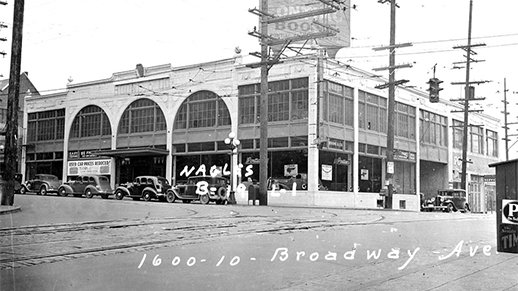HISTORIC CONTEXTS
Knowledge of the political, social, economic, and cultural setting is essential to gaining a more complete understanding of a particular historical person, place, or idea. These historical patterns and trends enhance our understanding of the meaning and historical significance of specific events and places. I have written and conducted research for numerous historic contexts (including for compliance under Section 106 of the National Historic Preservation Act), from site-specific histories to contexts covering specific topics or a large geographical area. Below are some examples of historic contexts I have written.
Seattle’s Auto Row Historic Context and Survey
I wrote an in-depth historic context about the growth of auto dealerships within the city of Seattle from 1900 through 1968, from the first “auto row” on Capitol Hill to suburban dealerships on Aurora Avenue and in Lake City. The research for the project involved extensive use of city directories to identify dealerships and track their development over time. The final report, “‘Along the Row’: The Growth of Seattle’s Auto Dealerships from 1900-1969,” is available as a reference document on the website of the Department of Archaeology and Historic Preservation in Washington state.
Snohomish County, Washington Historic Context and Historic Resources Inventory
This historic context identified historic themes, events, trends, and individuals significant in the history of rural Snohomish County. My research relied heavily on newspaper accounts to add detail to information from secondary sources. This context accompanied a historic resources survey of 203 historic-period residential and civic resources. The resulting survey report included the historic context, as well as physical descriptions, photos, and eligibility evaluations completed by a colleague. The report provided recommendations for further study to help guide Snohomish County through future phases of research on these rural properties.
Naval Weapons Systems Training Facility (NWSTF) Boardman Historic Context
I researched and wrote an early settlement study for NWSTF Boardman in Morrow County, Oregon. The historic context covered early exploration of the region through initial settlement in the 1850s and into the twentieth century. Part of the Oregon Trail runs across Morrow County and the history of the region reflects the many people who passed through it and eventually settled. The context includes a detailed ownership history of homestead and other land claims within the Naval facility’s boundaries. Research for the context included extensive use of online sources, including digitized newspapers and material available on Ancestry.com. I also conducted in-person research at the Morrow County Clerk’s office in Heppner, Oregon.
Union Pacific Alexandria Bridge Mitigation
I researched the history of the Texas & Pacific Line (now part of Union Pacific) for a project involving a proposed railroad bridge replacement in St. Landry Parish, Louisiana. The resulting historic context provided background on the importance of the Texas & Pacific Railway Company in connecting Louisiana with the Pacific Coast in the latter half of the nineteenth century. The railway, and its early leader Jay Gould, played a significant role in the railroad boom of the 1880s and 1890s, a formative era in U.S. history. The results of the survey and evaluation, including my historic context, assisted in determining appropriate management recommendations for affected properties.



